
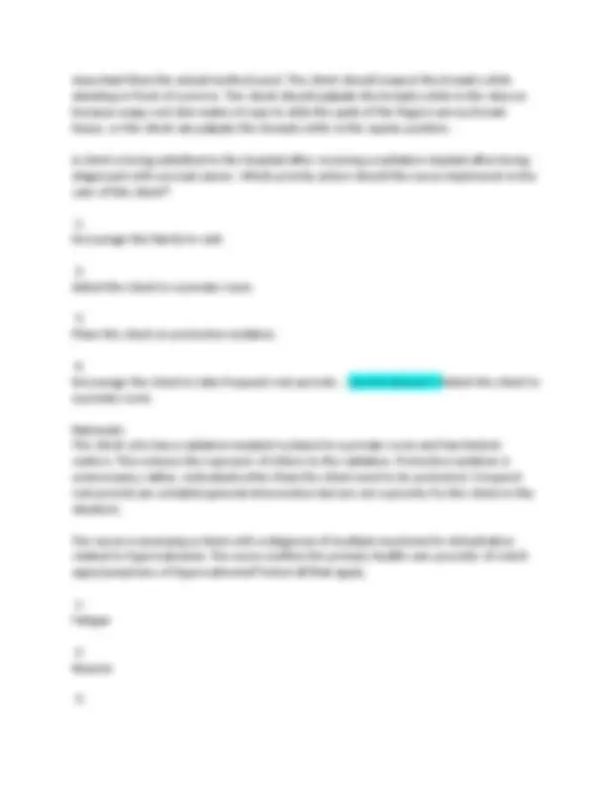



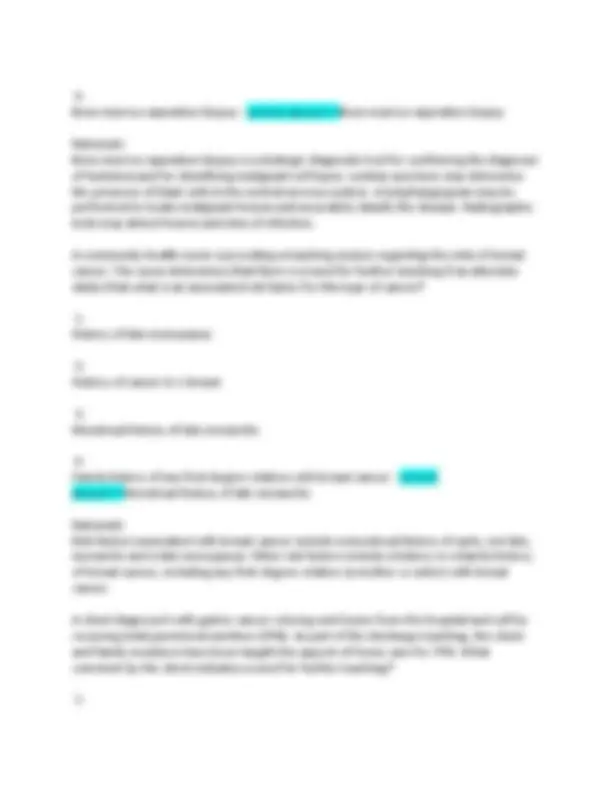
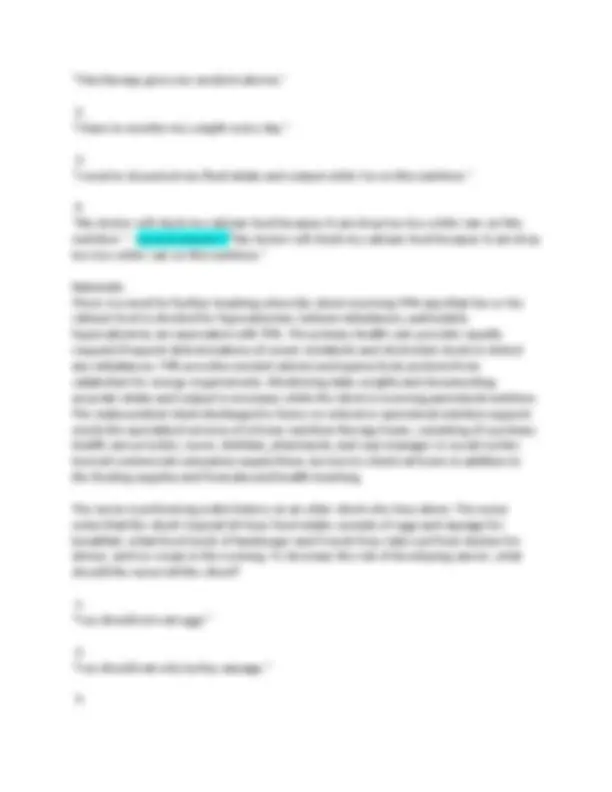

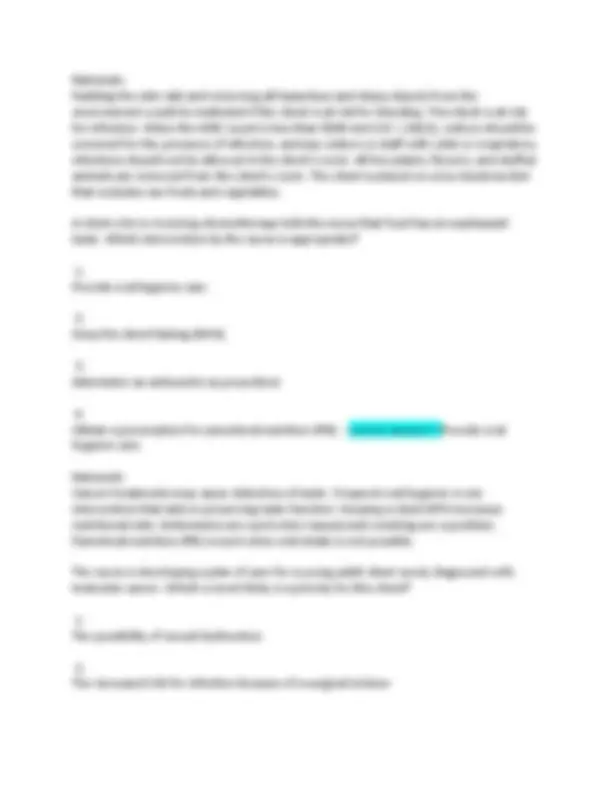
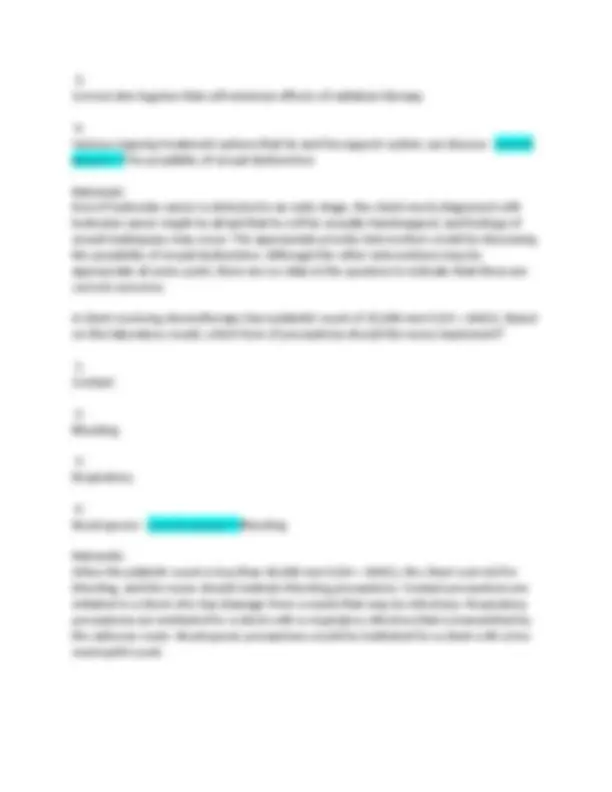
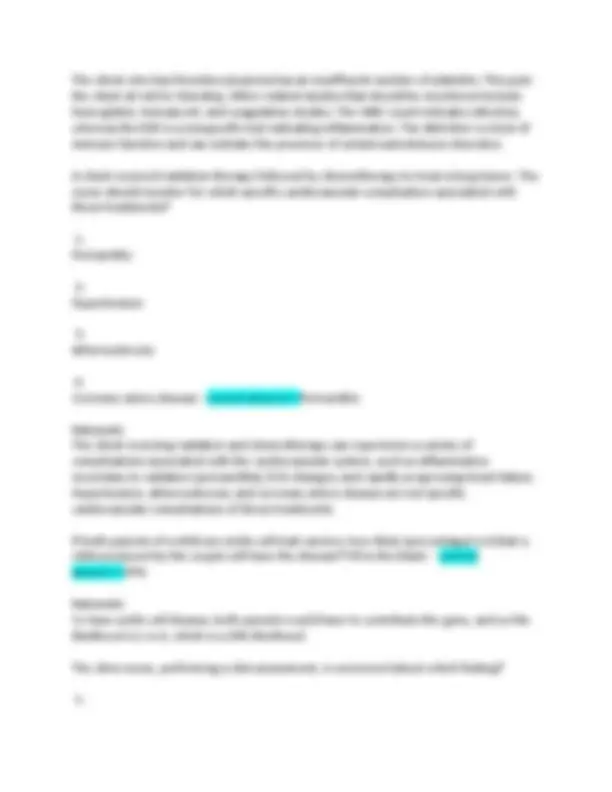

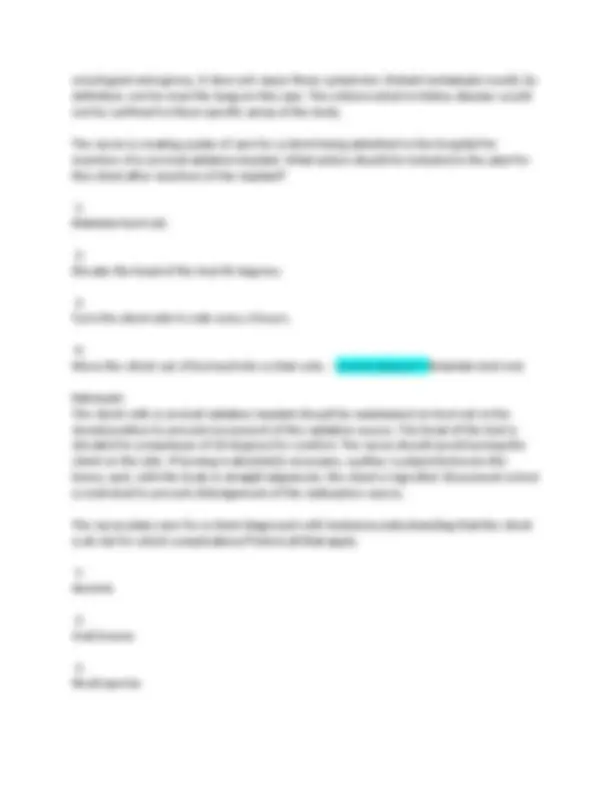
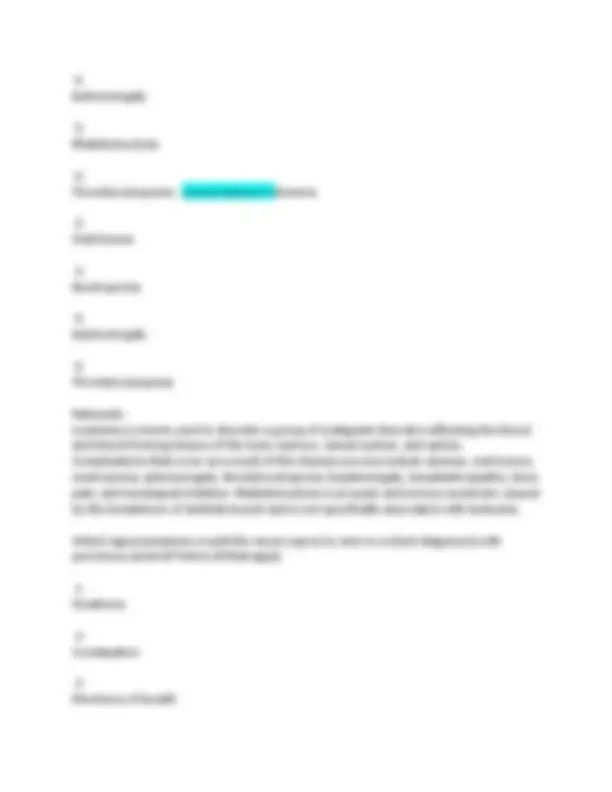

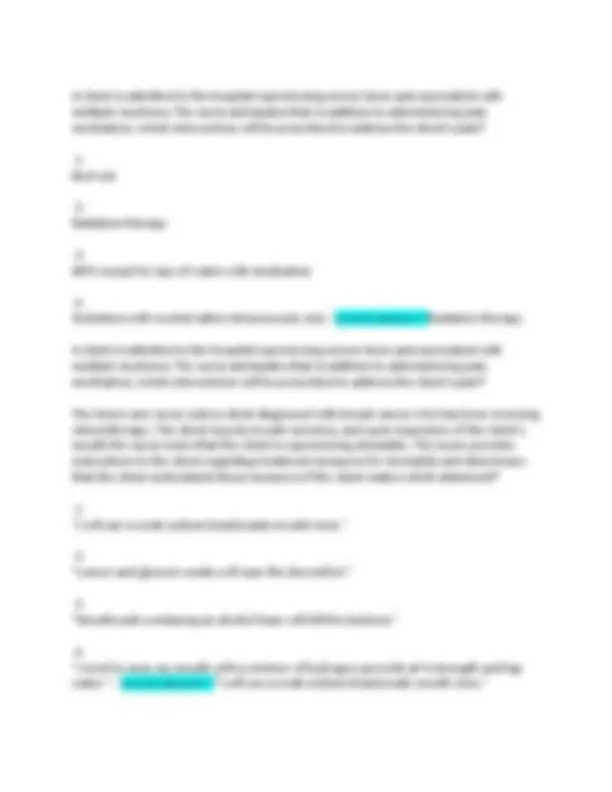
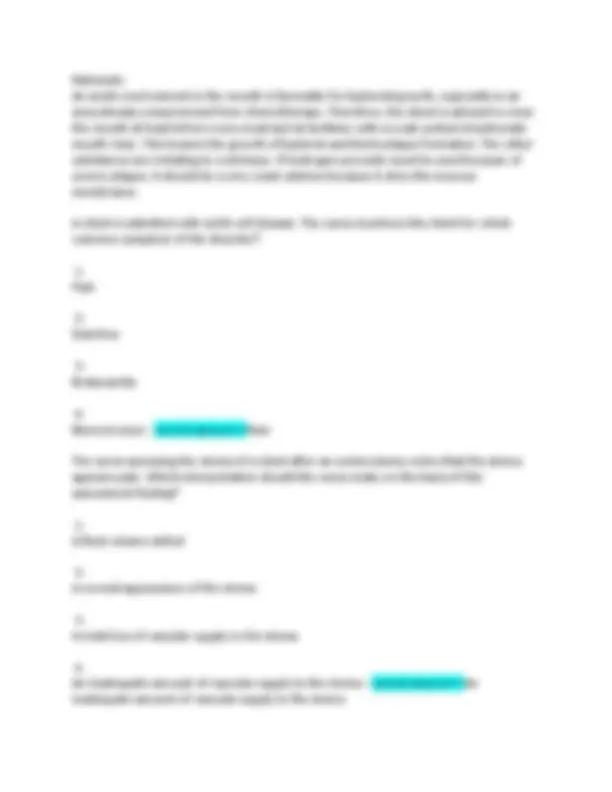
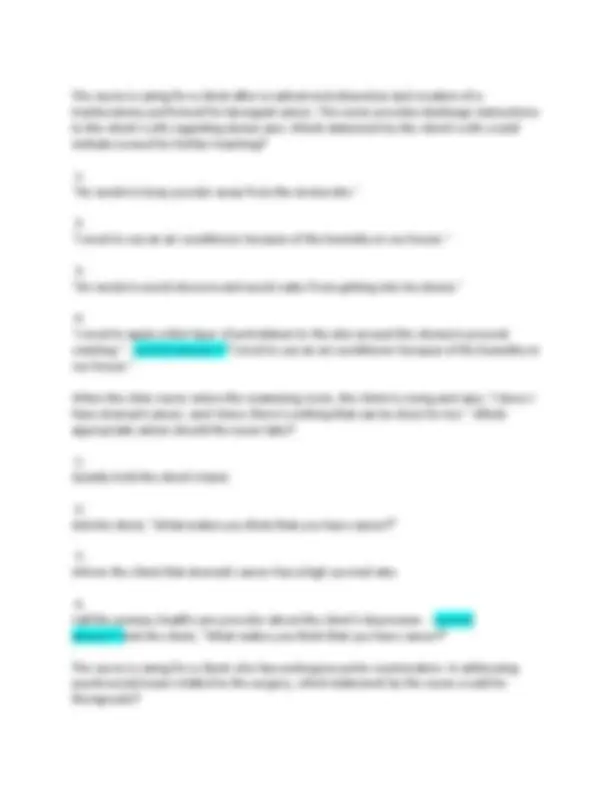
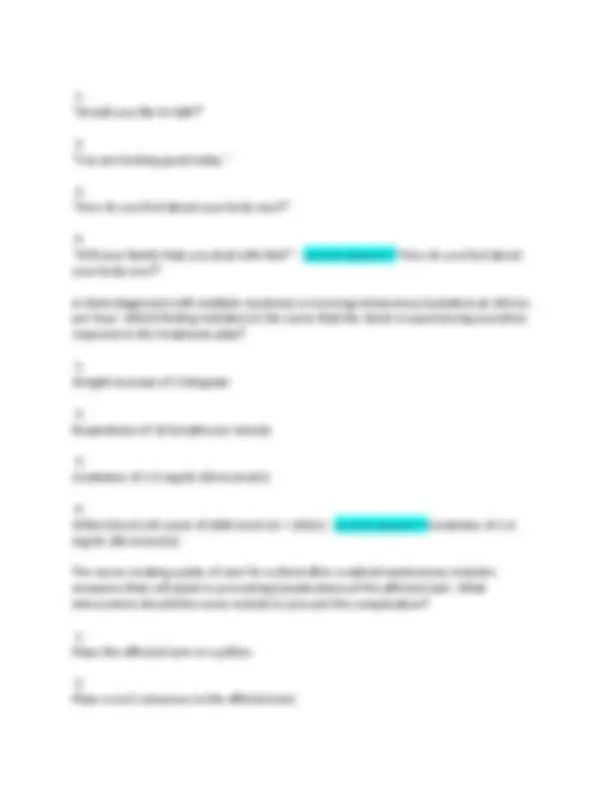


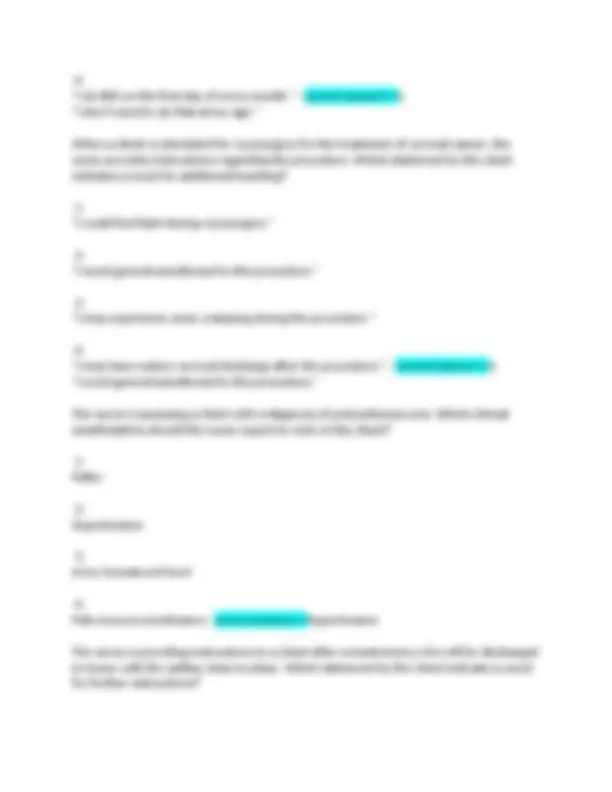

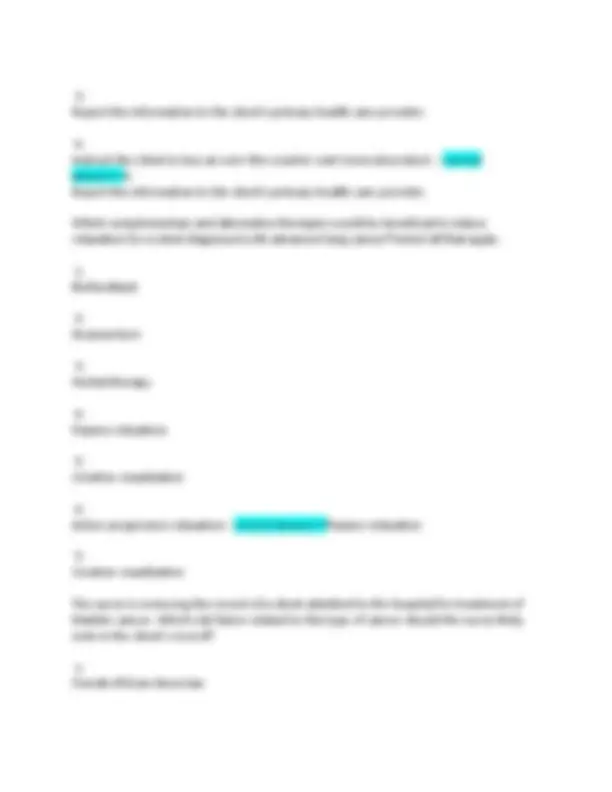
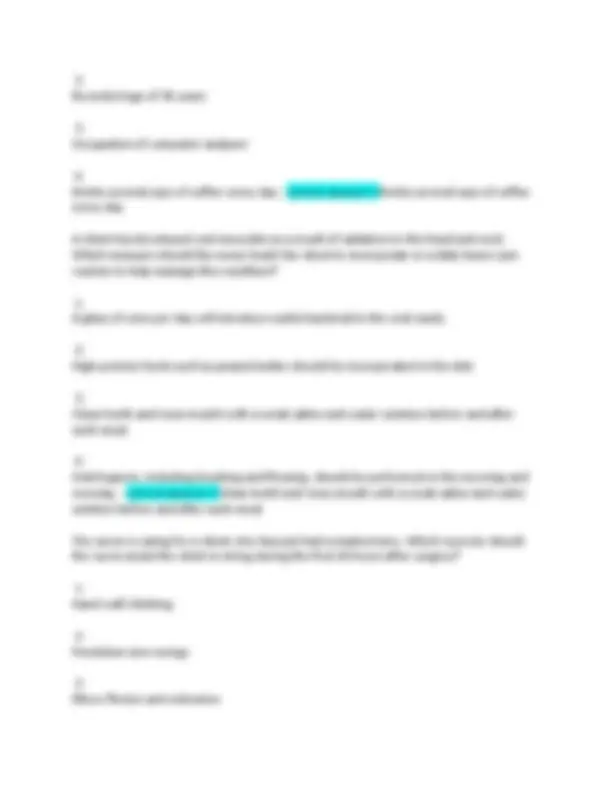

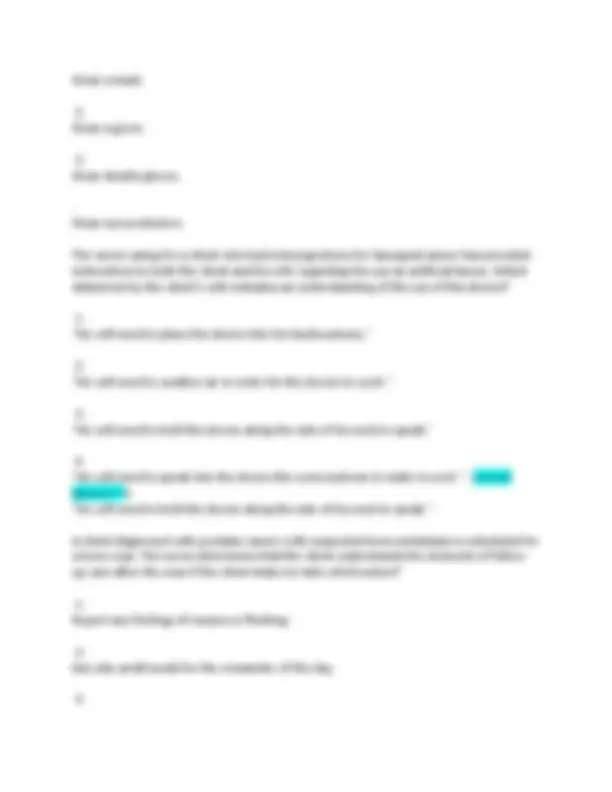
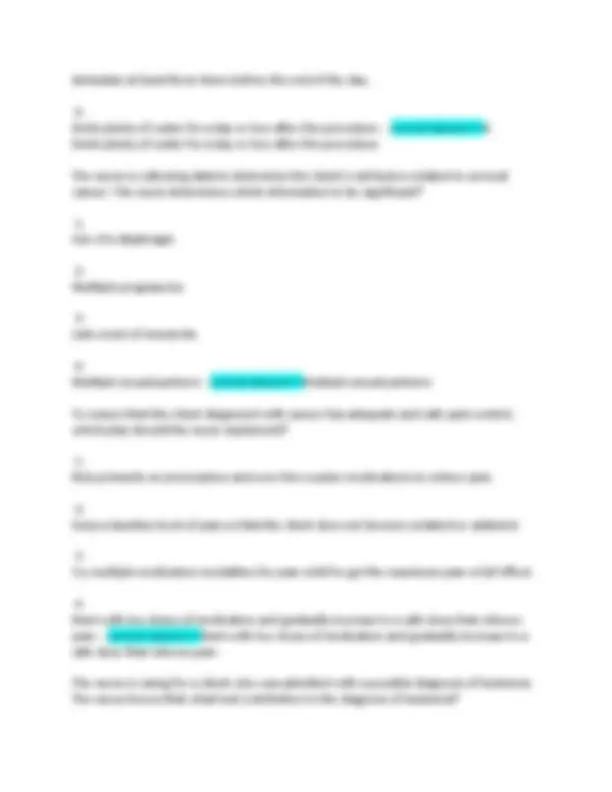
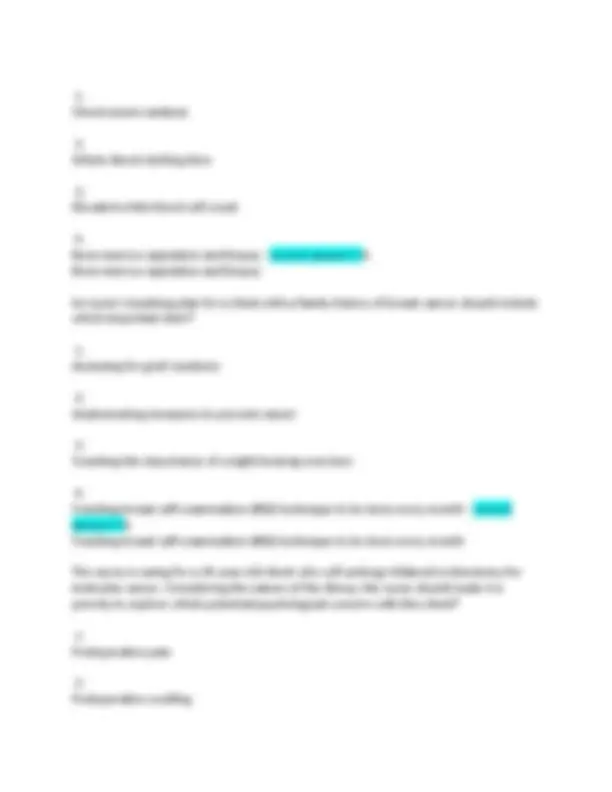


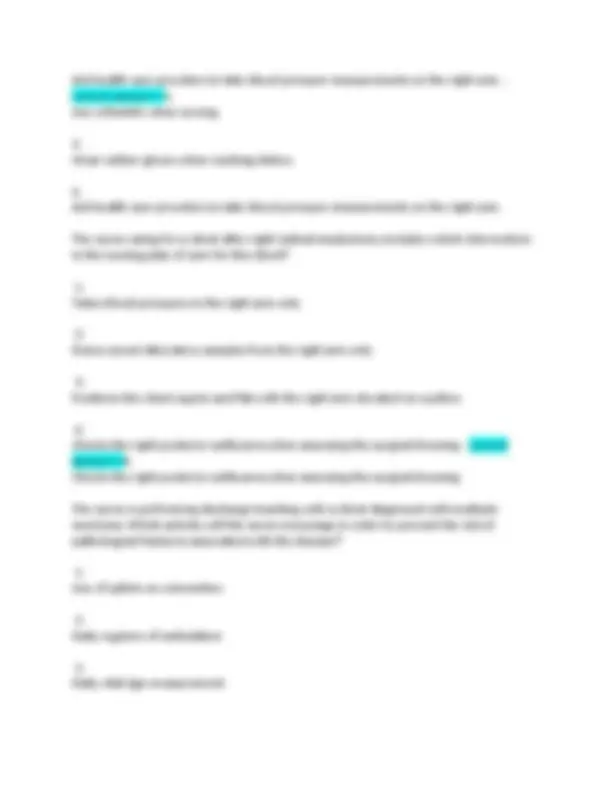
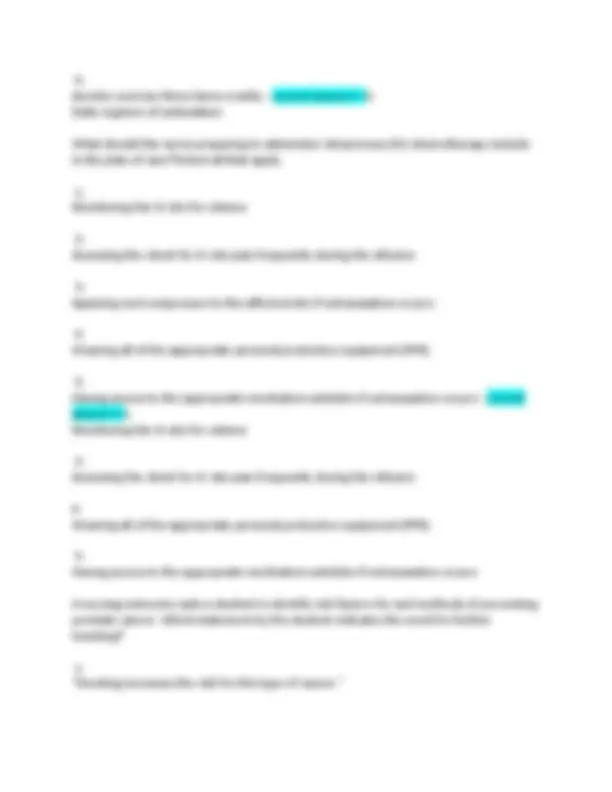
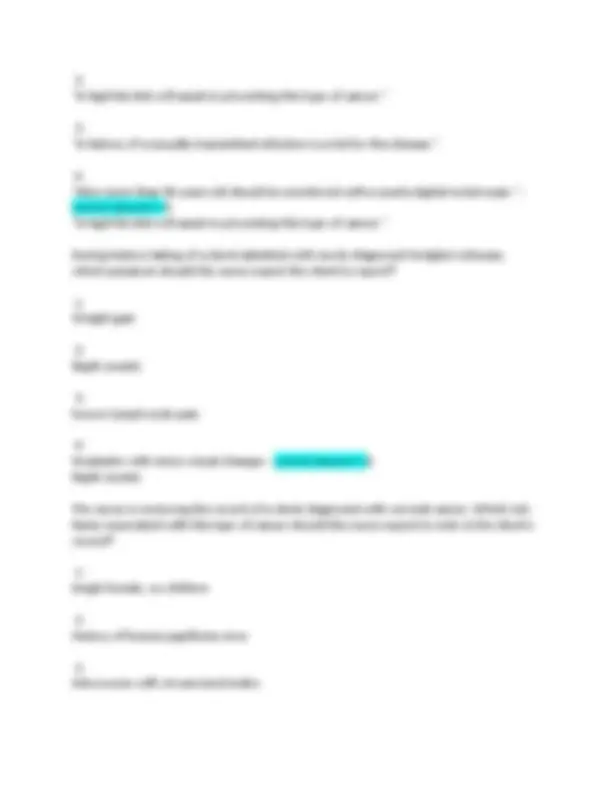
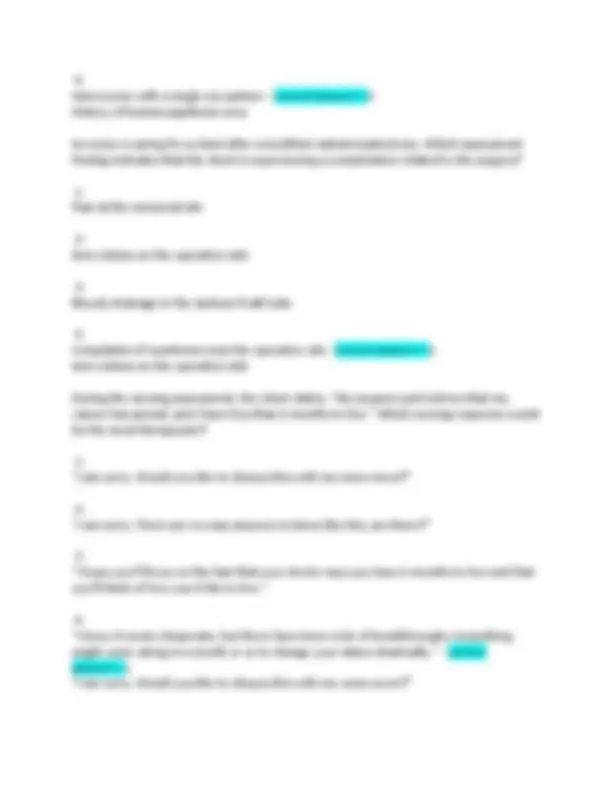
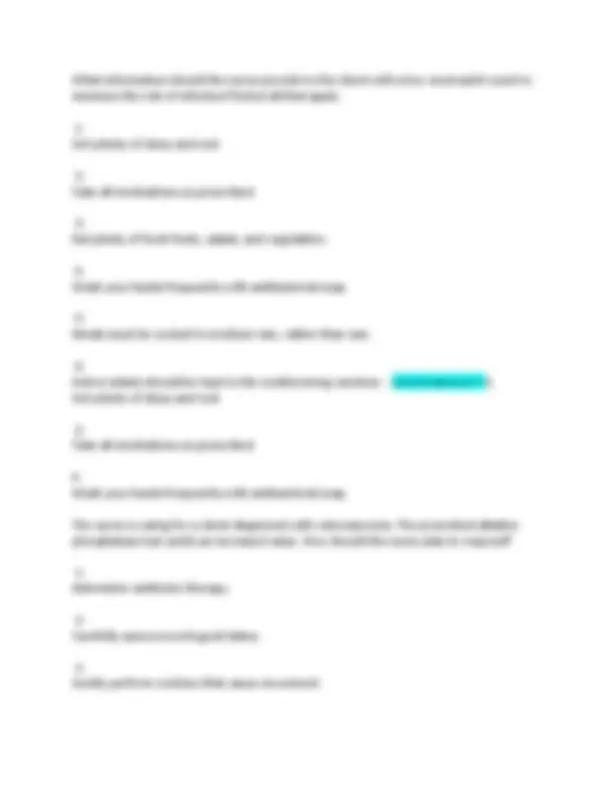
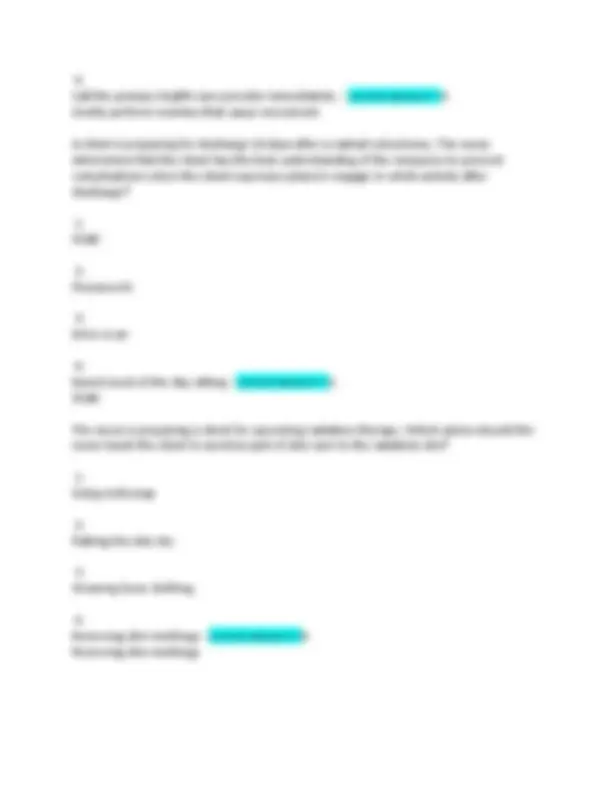
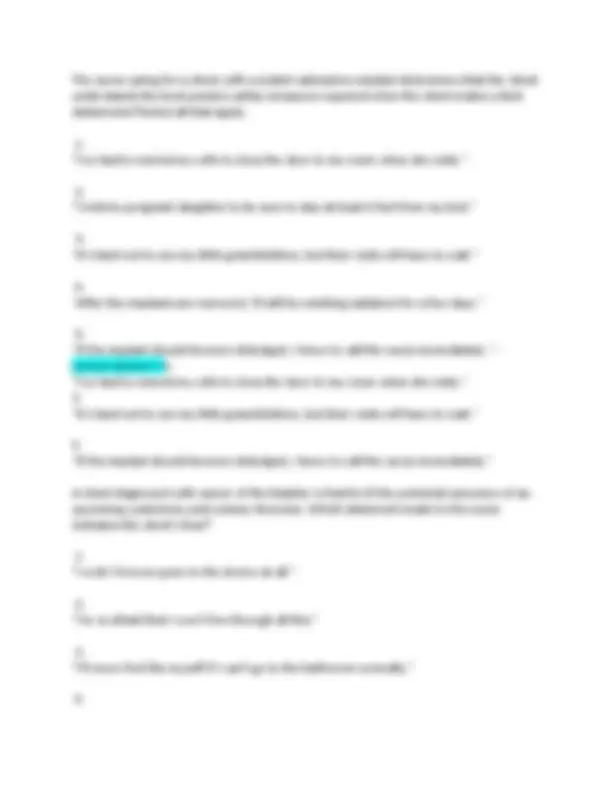
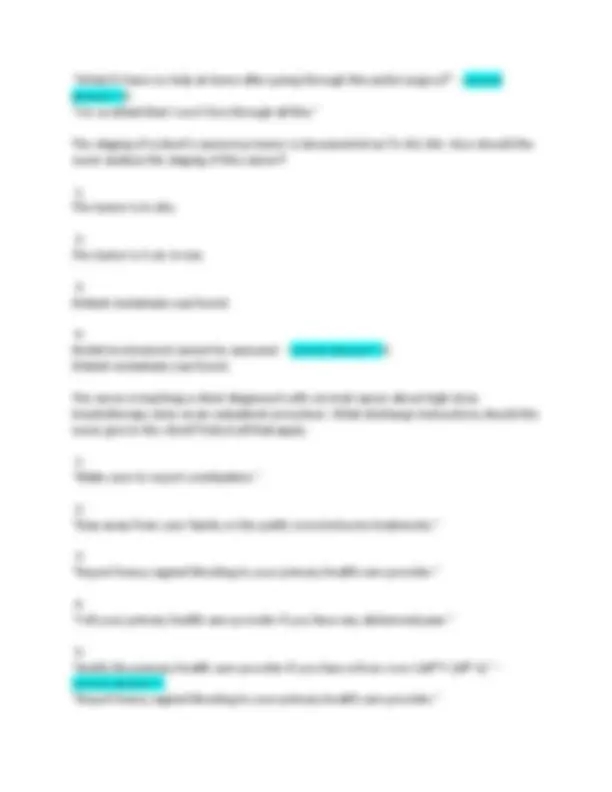

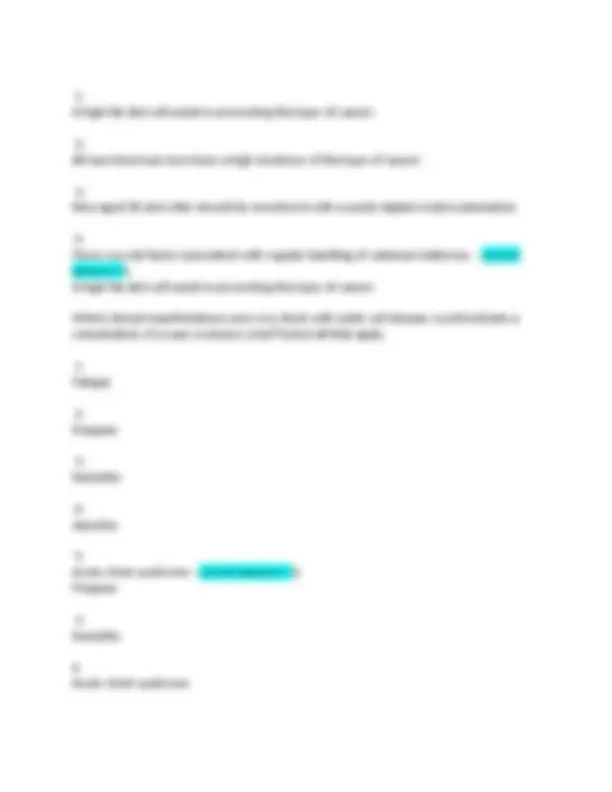
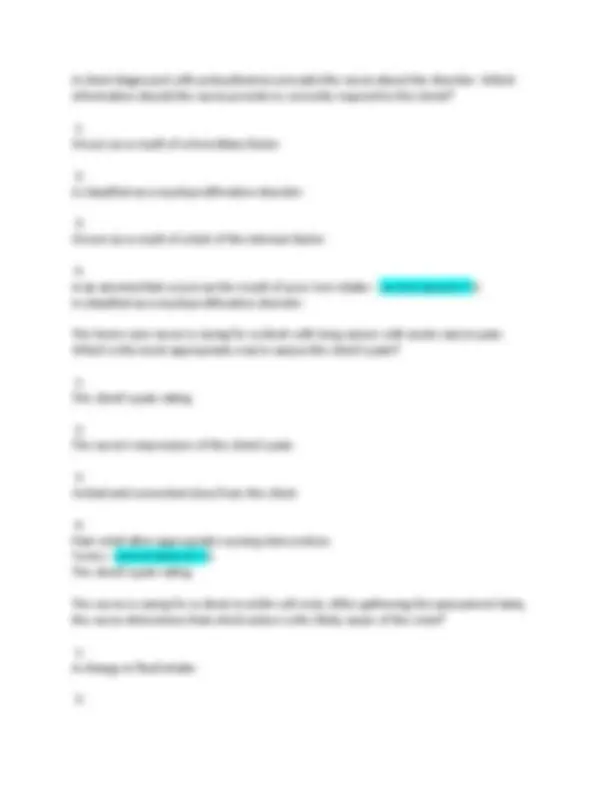
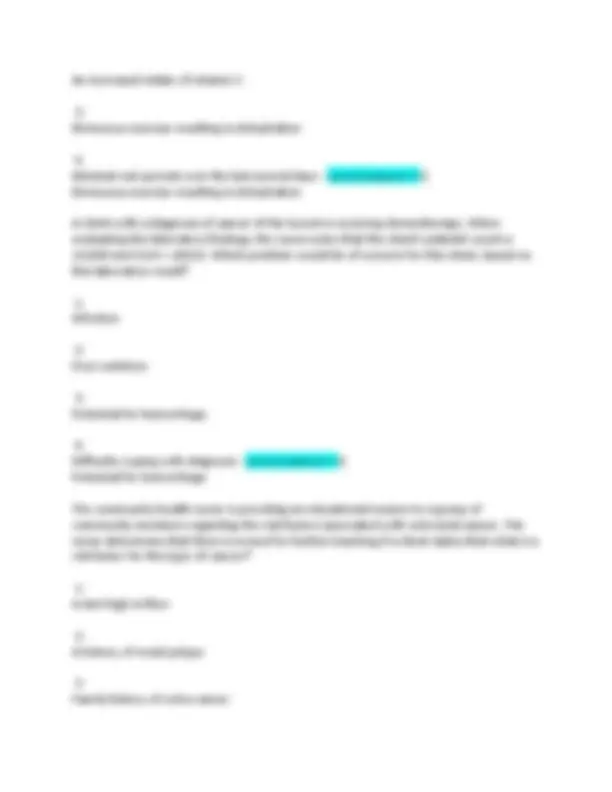

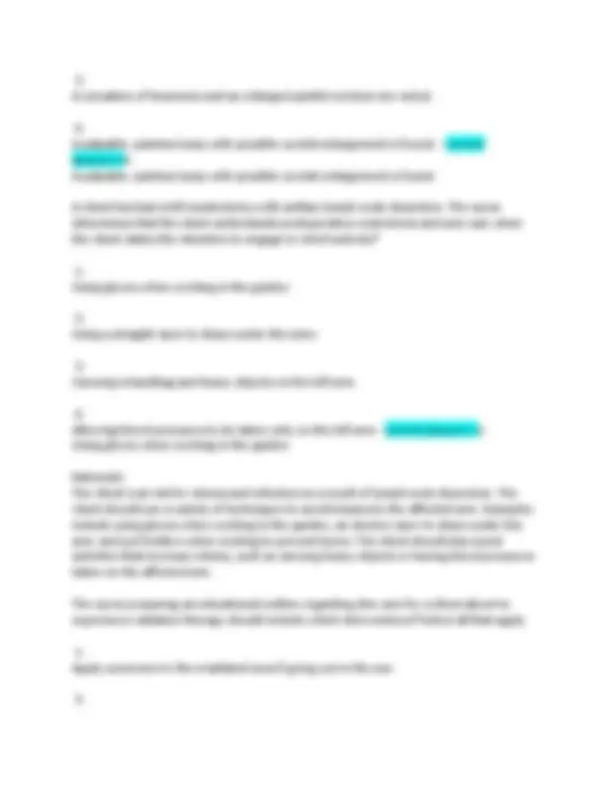
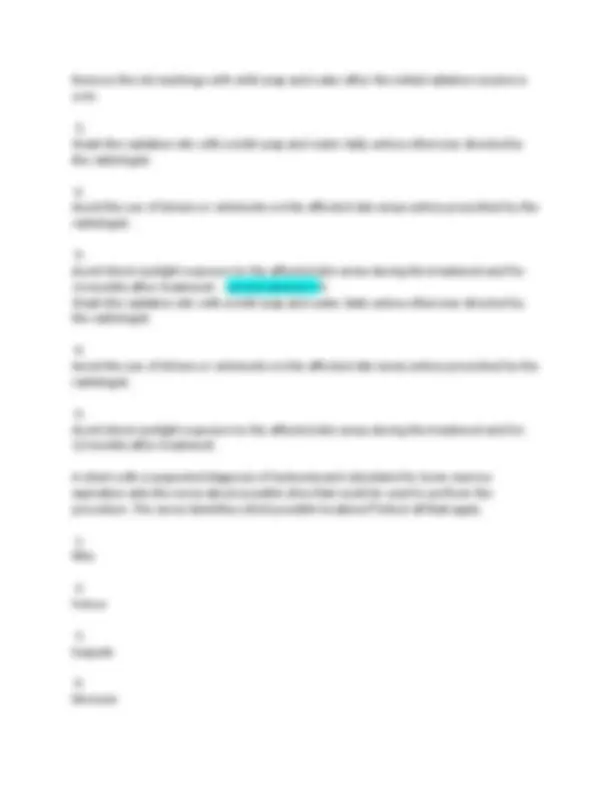




Study with the several resources on Docsity

Earn points by helping other students or get them with a premium plan


Prepare for your exams
Study with the several resources on Docsity

Earn points to download
Earn points by helping other students or get them with a premium plan
Community
Ask the community for help and clear up your study doubts
Discover the best universities in your country according to Docsity users
Free resources
Download our free guides on studying techniques, anxiety management strategies, and thesis advice from Docsity tutors
The nurse provides instructions to the client who received cryosurgery (cervical ablation) for a local stage 0 cervical tumor. Which instruction should the nurse give the client? 1. To avoid tub baths 2. That pain indicates a complication of the procedure 3. To call the primary health care provider if a watery discharge is noted 4. To call the primary health care provider discharge remains odorous after 1 week - correct answer>>1. To avoid tub baths Rationale: Healing after cryosurgery takes about 10 weeks. Tub baths and sitz baths need to be avoided. Showers or sponge baths should be taken during this time. Mild pain may occur and continue for several days after this procedure. A clear, watery discharge is expected. For about 14 days, this is followed by discharge that contains debris, which may be odorous. If the discharge continues for more than
Typology: Exams
1 / 55

This page cannot be seen from the preview
Don't miss anything!
















































The nurse provides instructions to the client who received cryosurgery (cervical ablation) for a local stage 0 cervical tumor. Which instruction should the nurse give the client?
To avoid tub baths
That pain indicates a complication of the procedure
To call the primary health care provider if a watery discharge is noted
To call the primary health care provider discharge remains odorous after 1 week - correct answer>>1. To avoid tub baths Rationale: Healing after cryosurgery takes about 10 weeks. Tub baths and sitz baths need to be avoided. Showers or sponge baths should be taken during this time. Mild pain may occur and continue for several days after this procedure. A clear, watery discharge is expected. For about 14 days, this is followed by discharge that contains debris, which may be odorous. If the discharge continues for more than 8 weeks, an infection is suspected. A client has undergone vaginal hysterectomy for the treatment of uterine cancer. In the postoperative plan of care, the nurse should avoid which activity?
Using pneumatic compression boots
Assisting with range-of-motion leg exercises
Removing antiembolism stockings twice daily
Elevating the knees and placing extra pillows under the knees - correct answer>>Elevating the knees and placing extra pillows under the knees Rationale: The client is at risk of deep vein thrombosis or thrombophlebitis after this surgery, as with any other major surgery. For this reason, the nurse implements measures that will prevent this complication. Pneumatic compression boots, range-of-motion exercises, and antiembolism stockings (if prescribed) are all helpful. The nurse should avoid using the knee gatch on the bed or elevating the knees with the use of pillows, which inhibits venous return, therefore placing the client more at risk for deep vein thrombosis or thrombophlebitis. The nurse has taught a postmenopausal woman at risk for breast cancer how to do breast self-examination (BSE). The nurse determines that the client understands the procedure if the client makes which statement?
"I will palpate my breasts while standing in front of the mirror."
"I will do the exam 14 days after the start of my menstrual cycle."
"I will use the pads of my fingers and press deeply to feel lumps."
"I will examine my right breast with my right hand, and vice versa." - correct answer>>"I will use the pads of my fingers and press deeply to feel lumps." Rationale: Women who are postmenopausal are taught to do BSE on the same day of every month. Before menopause, women should do the procedure 7 days after the start of the menstrual cycle when the breasts are least tender. Each breast is examined with the opposite hand. The pads of the fingers should be used for palpation, and the client should press deeply, feeling for lumps. The client may use a circular, up-and-down, or wedge method of assessment. Consistency of use of the same method is more
Diarrhea
Anorexia
Scant urine output - correct answer>>1. Fatigue
Nausea
Anorexia Rationale: Clients with multiple myeloma are at risk for hypercalcemia. Fatigue, nausea, anorexia, vomiting, polyuria, weakness, and constipation, along with dehydration, are signs/symptoms of moderate hypercalcemia. The nurse needs to monitor for these signs/symptoms and report them immediately to the primary health care provider. Activity is encouraged. A fluid intake of 3000 mL daily is required to dilute the calcium overload and to prevent protein from precipitating in the renal tubules. A high-calorie diet is encouraged, because a low-fiber diet can lead to constipation. A client is admitted to the hospital with a diagnosis of infiltrating ductal carcinoma of the breast. Which expected manifestation should the nurse assess the client for?
Bilateral palpable masses
Pain in the breast and edema
A fixed, irregularly shaped mass
A round-shaped mass that is moveable - correct answer>>A fixed, irregularly shaped mass Rationale:
Infiltrating ductal carcinoma of the breast usually presents as a fixed, irregularly shaped mass. The mass is usually single and unilateral and is painless, nontender, and hard to the touch. The nurse is teaching a client who is scheduled for radiation therapy about the therapy. Which statement by the client indicates a need for further teaching?
"I'm certain that this will do the trick."
"I will be radioactive after the therapy."
"This is just one of several options I have for treatment."
"This treatment is great, because it is invisible and very effective." - correct answer>>"I will be radioactive after the therapy." Rationale: A need for further teaching occurs when the client states that she or he will be radioactive after the therapy. Education by the nurse can eliminate the fear and misconceptions of radiation therapy and support the client and family. Some of the most common fears and misconceptions include fear of being burned, fear of being radioactive, the radioactive treatment, treatment failure, and the adverse effects. The remaining statements are correct although additional information may need to be provided to the client. The nurse is caring for a postoperative client who had a mastectomy with axillary lymph node dissection. How should the nurse position the client to promote prevent lymphedema?
Side-lying on the affected side
Supine with the client's head resting on one pillow
documented that the client has a right colon tumor. Which clinical manifestation should the nurse expect the client to report when obtaining subjective data from the client?
Diarrhea
Crampy gas pains
Flat ribbon-like stools
Dull abdominal pain exacerbated by walking - correct answer>>Dull abdominal pain exacerbated by walking Rationale: Characteristic signs/symptoms of right colon tumors include vague, dull abdominal pain exacerbated by walking, and dark red or mahogany-colored blood mixed in the stool. The other signs/symptoms are associated with left colon tumors. The nurse has completed discharge teaching with a client who has had surgery for lung cancer. The nurse determines that the client needs additional teaching about the elements of home management if the client verbalizes the need to follow which instruction?
Avoid exposure to crowds.
Deal with any increases in pain independently.
Sit up and lean forward to breathe more easily.
Call the primary health care provider if shortness of breath occurs. - correct answer>>Deal with any increases in pain independently. Rationale:
The client who just had surgery for lung cancer should not be expected to deal with increases in pain independently. Health teaching includes avoiding exposure to crowds or persons with respiratory infections and reporting signs and symptoms of respiratory infection or increases in pain. The client should also use positions that facilitate respiration, such as sitting up and leaning forward. A client has undergone a mastectomy. The nurse determines that the client is having the most difficulty adjusting to the loss of the breast when which behavior is observed?
Refuses to look at the dressing
Requires help with sponge bathing
Asks that the nurse limit visitors to only family
Dresses in a loose nightgown the client brought from home - correct answer>>Refuses to look at the dressing Rationale: The client demonstrates the most difficult adjustment to the loss if she refuses to look at the dressing. This indicates that the client is not ready or willing to begin to acknowledge and cope with the surgery. Requiring help with sponge bathing is expected after major surgery, limiting visitors is also an expected behavior soon after surgery, and dressing in her own nightgown indicates that the client is retaining her self-esteem. The nurse is caring for a client with a diagnosis of suspected leukemia. The nurse prepares the client for which diagnostic test that would confirm this diagnosis?
Lumbar puncture
Lymphangiogram
Radiographic tests
"This therapy gives me needed calories."
"I have to monitor my weight every day."
"I need to document my fluid intake and output while I'm on this nutrition."
"My doctor will check my calcium level because it can drop too low while I am on this nutrition." - correct answer>>"My doctor will check my calcium level because it can drop too low while I am on this nutrition." Rationale: There is a need for further teaching when the client receiving TPN says that her or his calcium level is checked for hypocalcemia. Calcium imbalances, particularly hypercalcemia, are associated with TPN. The primary health care provider usually requests frequent determinations of serum metabolic and electrolyte levels to detect any imbalances. TPN provides needed calories and spares body proteins from catabolism for energy requirements. Monitoring daily weights and documenting accurate intake and output is necessary while the client is receiving parenteral nutrition. The malnourished client discharged to home on enteral or parenteral nutrition support needs the specialized services of a home nutrition therapy team, consisting of a primary health care provider, nurse, dietitian, pharmacist, and case manager or social worker. Several commercial companies supply these services to clients at home in addition to the feeding supplies and formulas and health teaching. The nurse is performing a diet history on an older client who lives alone. The nurse notes that the client's typical 24-hour food intake consists of eggs and sausage for breakfast, a fast-food lunch of hamburger and French fries, take-out fried chicken for dinner, and ice cream in the evening. To decrease the risk of developing cancer, what should the nurse tell the client?
"You should not eat eggs."
"You should eat only turkey sausage."
"A high-fat diet increases the risk for colon cancer."
"Drinking a lot of alcohol increases the risk of liver cancer." - correct answer>>"A high- fat diet increases the risk for colon cancer." Rationale: A high-fat diet increases the risk of breast, prostate, and colon cancer. Although eggs and sausage are high in fat, they are not the only high-fat foods addressed in the question. Hamburger, fries, fried chicken, and ice cream are also high in fat. Drinking large quantities of alcohol does increase the risk of liver cancer, but drinking alcohol is not mentioned in the question. he nurse is caring for a client diagnosed with metastatic lung cancer. The client was medicated 2 hours ago and now reports a new and sudden sharp pain in the back. What should the nurse interpret is the cause of this assessment finding?
Further metastasis
A low pain threshold
Spinal cord compression
The need for an increase in pain medication - correct answer>>Spinal cord compression Rationale: Spinal cord compression should be suspected in a client with metastatic disease, particularly when a new and sudden onset of back pain occurs. Spinal cord compression causes back pain before neurological changes occur. Spinal cord compression is an oncological emergency, and the primary health care provider should be notified. No data in the question support a low pain threshold. Further metastasis and the need for more pain medication may be accurate but are not the most appropriate interpretation of the new and sudden pain that developed. The home care nurse visits a client diagnosed with cancer who recently received a course of chemotherapy. The client has developed stomatitis, and the nurse provides
Upon same day discharge, tell the client to avoid any activity that could lead to trauma to the site for 48 hours. - correct answer>>Cover the site with a dressing after bleeding is controlled.
Observe the site for 24 hours for signs/symptoms of bleeding and infection.
Upon same day discharge, tell the client to avoid any activity that could lead to trauma to the site for 48 hours. Rationale: The nursing priority after a bone marrow aspiration or biopsy is prevention of excessive bleeding. The site needs to be covered with a dressing after bleeding is controlled, and closely observed for 24 hours for signs of bleeding and infection. A mild analgesic (aspirin-free) may be given for discomfort, and ice and not hot packs can be placed over the site to limit bruising. If the client goes home the same day as the procedure, instruct him or her to inspect the site every 2 hours for the first 24 hours to assess for active bleeding or bruising. Advise the client to avoid any activity that might result in trauma to the site for 48 hours. A client with the diagnosis of leukemia is receiving chemotherapy. When the registered nurse (RN) notes that the white blood cell (WBC) count is 4000 mm3 (4 × 109/L), the new nurse caring for the client is informed about the results. Which intervention identified by the new nurse indicates a need for further teaching?
Restricting visitors with colds or respiratory infections
Removing all live plants, flowers, and stuffed animals in the client's room
Placing the client on a low-bacteria diet that excludes raw foods and vegetables
Padding the side rails and removing all hazardous and sharp objects from the room - correct answer>>Padding the side rails and removing all hazardous and sharp objects from the room
Rationale: Padding the side rails and removing all hazardous and sharp objects from the environment would be instituted if the client is at risk for bleeding. This client is at risk for infection. When the WBC count is less than 5000 mm3 (5 × 109/L), visitors should be screened for the presence of infection, and any visitors or staff with colds or respiratory infections should not be allowed in the client's room. All live plants, flowers, and stuffed animals are removed from the client's room. The client is placed on a low-bacteria diet that excludes raw fruits and vegetables. A client who is receiving chemotherapy tells the nurse that food has an unpleasant taste. Which intervention by the nurse is appropriate?
Provide oral hygiene care.
Keep the client fasting (NPO).
Administer an antiemetic as prescribed.
Obtain a prescription for parenteral nutrition (PN). - correct answer>>Provide oral hygiene care. Rationale: Cancer treatments may cause distortion of taste. Frequent oral hygiene is one intervention that aids in preserving taste function. Keeping a client NPO increases nutritional risks. Antiemetics are used when nausea and vomiting are a problem. Parenteral nutrition (PN) is used when oral intake is not possible. The nurse is developing a plan of care for a young adult client newly diagnosed with testicular cancer. Which is most likely is a priority for this client?
The possibility of sexual dysfunction
The increased risk for infection because of a surgical incision
The nurse is assessing a client who is admitted to the hospital for diagnostic studies to rule out the presence of Hodgkin's disease. Which question should the nurse ask the client to elicit information specifically related to this disease?
"Are you tiring easily?"
"Do you have any weakness?"
"Have you gained any weight recently?"
"Have you noticed any swollen lymph nodes?" - correct answer>>"Have you noticed any swollen lymph nodes?" Rationale: Hodgkin's disease is a chronic, progressive neoplastic disorder of lymphoid tissue characterized by the painless enlargement of lymph nodes with progression to extralymphatic sites, such as the spleen and liver. Fatigue and weakness may occur but are not significantly related to the disease. Weight loss is most likely to be noted. client receiving chemotherapy has an infiltrated intravenous line and extravasation at the site. Which actions should the nurse prepare to take in the management of this situation? Select all that apply.
Leave the needle in place.
Aspirate any residual medication.
Apply direct manual pressure to the site.
Stop the administration of the medication.
Administer an available antidote as prescribed. - correct answer>>Leave the needle in place.
Aspirate any residual medication.
Stop the administration of the medication.
Administer an available antidote as prescribed. Rationale: Extravasation is the leakage of medication into surrounding skin and subcutaneous tissue. Agency procedures are followed if the client experiences extravasation. However, general recommendations for managing extravasation of a chemotherapeutic agent include stopping the infusion, leaving the needle in place, attempting to aspirate any residual medication from the site (the needle would be removed after treatment of the event), administering an antidote if available, and assessing the site for complications. Direct pressure is not applied to the site because it could further injure tissues exposed to the chemotherapeutic agent. A client diagnosed with cancer develops thrombocytopenia secondary to adverse effects of chemotherapy. Based on this disorder, the nurse should primarily monitor the results of which laboratory study closely?
Platelet count
White blood cell (WBC) count
Antinuclear antibody titer (ANA)
Erythrocyte sedimentation rate (ESR) - correct answer>>Platelet count Rationale:
Dimpling of the skin
The presence of genital warts
A mole with round, smooth borders
Client report that a mole has changed to blue - correct answer>>Client report that a mole has changed to blue Rationale: Shades of blue in a mole are considered ominous for malignant melanoma. Dimpling of the skin in the breast area may be associated with breast cancer. Genital warts may be associated with cancer of the cervix. A mole with round, smooth borders would indicate a normal finding. The home care nurse has been visiting a client diagnosed with lung cancer weekly over the past month. Over time, the nurse notes increasing dyspnea and increasing edema of the face and arms of the client. The nurse analyzes these signs/symptoms and determines that they are consistent with which condition?
Kidney failure
Distant metastasis
Spinal cord compression
Superior vena cava syndrome - correct answer>>Superior vena cava syndrome Rationale: The superior vena cava is the large vessel that accepts blood from the head, neck, and arms, returning it to the heart. Therefore, compression of this vessel by a tumor or by enlarged lymph nodes can cause decreased blood return from these areas, resulting in swelling and increased dyspnea. Although spinal cord compression is another
oncological emergency, it does not cause these symptoms. Distant metastasis would, by definition, not be near the lungs in this case. The edema noted in kidney disease would not be confined to these specific areas of the body. The nurse is creating a plan of care for a client being admitted to the hospital for insertion of a cervical radiation implant. What action should be included in the plan for this client after insertion of the implant?
Maintain bed rest.
Elevate the head of the bed 45 degrees.
Turn the client side to side every 2 hours.
Move the client out of bed and into a chair only. - correct answer>>Maintain bed rest. Rationale: The client with a cervical radiation implant should be maintained on bed rest in the dorsal position to prevent movement of the radiation source. The head of the bed is elevated to a maximum of 20 degrees for comfort. The nurse should avoid turning the client on the side. If turning is absolutely necessary, a pillow is placed between the knees, and, with the body in straight alignment, the client is logrolled. Movement in bed is restricted to prevent dislodgement of the radioactive source. The nurse plans care for a client diagnosed with leukemia understanding that the client is at risk for which complications? Select all that apply.
Anemia
Oral lesions
Neutropenia